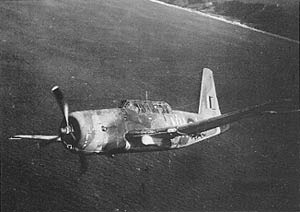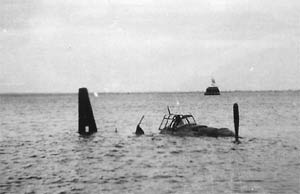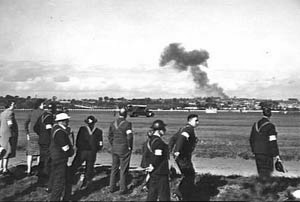|
||||||||||
|
|
||||||||||
|
|
In July 1989 my brother Colin and I were directed to a strange anomaly on the seabed off Williamstown by Phillip McCubbin, a local professional fisherman. The anomaly showed up on his sidescan sonar and depth sounder. I went down first to investigate, half expecting to find another piece of the Kakariki. I was more than a bit surprised when I noticed that this piece of wreckage had wings. This turned out to be the remains of a Vultee Vengeance dive-bomber which crashed into the water off Williamstown in March 1946. The site was subsequently reported to the Victorian Maritime Heritage Unit. Research What seemed like a very simple task of identifying the site turned into a three year struggle to find anything that resembled fact. The RAAF museum at Point Cook was contacted by phone to see if they knew anything about a plane crashing off Williamstown. Their files, it seems, are far from complete and they had no record of an accident there. They were quite surprised to hear about the find. The museum at the base was visited to see if by viewing the old planes on display a match could be made, but this was unsuccessful. Various books on planes used by the RAAF were studied, but it proved too hard to make a perfect match.
A number of long time locals were spoken to in Williamstown, and although there were conflicting stories of a plane crashing, no one seemed to know the date, and the details were very vague. As it turned out, there were two planes that had crashed in the area. The other was an Avro Anson that crashed to the north-east of the old Gellibrand light. The report read: "6/3/46 1050 Small plane, A27 - 505 made crash landing near shore Gellibrand Point, pilots Navy R.A.A.F. wind 12 m.p.h. Vis. 10 - 12 miles (Reported Chairman, Secretary Dredging Ann St. tide 7" on.)".
After finding this vital piece of information, the Williamstown Advertiser, Williamstown Chronicle, The Sun and Herald were read, and articles found and photocopied. The photographs in the Sun and Herald showed that the plane had landed in shallow water just off the back beach. I can only assume that the plane was somehow moved out to where it rests now, possibly by the same people who were cutting up and dumping the remains of the Kakariki at the back of the old rifle range.
The Kakariki was a steamer that was sunk in a collision with the steamer Carradale in 1937. The Kakariki was later cut up and moved to a place called the Blowhole off the old Rifle range. The Carmen was a wooden lighter broken up behind the old Williamstown rifle range in 1936. Details of the crash
On the 6 March 1946, a Vultee Vengeance with pilot Warrant Officer F.O. Knudson from South Australia and observer, Warrant Officer L.R. Wastell of Northcote, Victoria, was towing a target for gunnery practice at the Point Cook Airbase.
The Vultee Vengeance was regarded by most RAAF men as unsafe. They were condemned as unsafe for dive bombing in 1944. The planes were used after this for towing targets, but most pilots thought that they were not even safe enough for that task. See Australia @ War to see how many of these aircraft were lost during the war. Information provided by RAAF Researcher Daniel Leahy has identified that the Vengeance located off Williamstown and carrying the RAAF serial number A27-505 as a Vultee A-35B-VN Vengeance Mk. IV aircraft. It was given the USAAF serial number 41-31303 before being delivered to the RAAF on December 24, 1943. Between March and June 1944 this aircraft served with the 25 Squadron. After delivery to the Central Flying School based at Point Cook on November 29, 1945 the aircraft was modified to a target-tug aircraft for use by the Flying School. Some 3 months later on March 6, 1946 the Vengeance crashed into the sea off Williamstown due to an engine failure probably due to a loss of oil pressure.
Site features The site plan gives a good idea of what is left: there are two wings and part of the centre fuselage. The tail and engine are missing from the plane. The engine has since been found a few hundred metres away. The ends of the propeller are broken off and the engine is half buried in the mud bottom. One end of the right wing is missing and the end of the left wing is almost broken off. The plane seems to have been stripped of anything of value before being dumped as there are no instruments or seats. The visibility on the plane would rarely exceed two metres and once a few divers are down it is even less. Identification of the site
I didn't think at the time of finding the plane that it would prove such a difficult task to find out what it was. Who could forget a plane crashing? After not being able to identify the craft, it was decided to measure and then draw up a site plan to see if this might help in some way. At least I would have the dimensions of the aircraft.
Recommendation Phillip McCubbin located what appeared to be the missing engine in May 1994 and kindly took me out to have a look at it not long after. If the engine could be raised and placed at the front of the plane where it belongs the overall picture of the wreck would improve and most of the craft would then be in one spot. I think that the MAAV could achieve this objective. All that has to be found then is the tail which Phillip will more than likely find in the future. Technical Details
* Wing span 14.64 metres. Acknowledgements Thank you to the divers that helped out on the field trips: Eric Langenberg, Frank Derksen, Marteen Vanettie, Wayne Caldow, Cate Venturoni, Alan Blackstock, Peter Charlesworth, Gary Smith, Malcolm Venturoni, Mick Jackiew and Kieran Hosty from the Maritime Archaeology Unit. Thanks to RAAF Researcher Daniel Leahy for historical information. Thanks to Alfred Price for the use of image 'Vultee Vengeance wreckage at Williamstown'.
Written permission from the M.A.A.V. is required for the publication of any material. Any use of this material should credit the Maritime Archaeology Association Of Victoria.
Last modified: March, 2011 |
|||||||||



